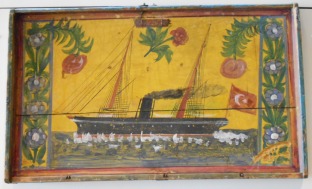Open: Wednesdays, Thursdays and Fridays 9am-5pm; Saturdays and Sundays 10am-6pm
Closed: Mondays
Admission: TL60
Contact info: Tel: 0212-327 4345, www.denizmuzeleri.tsk.tr/idmk/
Address: Beşiktaş Meydanı (Square), Beşiktaş
Transport info: Buses to Beşiktaş from Kabataş stop almost in front of the museum. So do dolmuşes from Taksim. The museum is just round the corner from the ferry terminals for Üsküdar and Kadıköy.
In 2013 the Deniz Müzesi reopened after a whole new building was created to house its many magnificent caiques, the long, slender rowing boats that were once used to ferry people around the Bosphorus. The finest are the imperial caiques used to transport the sultan and his family. Most of the caiques on display date from the latter half of the 19th century or the first half of the 20th century.
The oldest ship on display – and perhaps the finest – is the Historical Galley believed to have been built at the very end of the 16th century during the reign of Sultan Mehmed III. Nine different types of wood were used in its creation and its lavishly decorated superstructure is inlaid with mother-of-pearl. Almost 40m long, the galley required 24 pairs of oars, each of them rowed by three men so that there were a total of 144 oarsmen on board.
Not quite as visually striking but of great historical importance is the İnebolu caique found in a shed in the Black Sea town of İnebolu in 1992 and since restored. During the Turkish War of Independence, it is believed to have been used to transport ordnance from ships at anchor to the shore whence it was carried by ox cart along the İstiklal Yolu (Independence Way) to Ankara
So impressive are the caiques that it’s easy to overlook the other items on display in the light-filled main gallery. These include many paintings of boats and the İstanbul shoreline, including images by Amadeo Precioso and a wonderful panorama of İstanbul from Beyoğlu painted while sitting on the balcony of the Galata Tower in 1800 by the visiting English artist, Henry Aston Barker (1774-1856).
Also worth noting is the lovely bronze cannon in the shape of a dragon that was captured at the Second Siege of Vienna by Merzifonlu Kara Mustafa Paşa in 1683.
 Upstairs there is a collection of early 20th-century folk art images of ships in full sail painted on the inside of the wooden sandıks (dowry boxes) that used to be household staples.
Upstairs there is a collection of early 20th-century folk art images of ships in full sail painted on the inside of the wooden sandıks (dowry boxes) that used to be household staples.
The basement contains a variety of ship’s heads and prows, as well as mid-19th-century 3D images of İstanbul by Mıgırdiç Melkon. Here, too, can be found a length of the thick chain that used to be used to close off the Golden Horn to enemy shipping in the 15th century.
The museum has a cafe and gift shop as well as a very good children’s section on the ground floor.
Outside in the main square of Beşiktaş don’t miss the statue of the great 16th-century admiral, Hayreddin Barbarossa (1478-1546), known to the West as Barbarossa (“Red Beard”).


